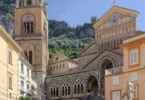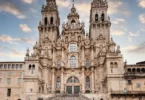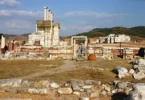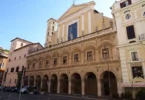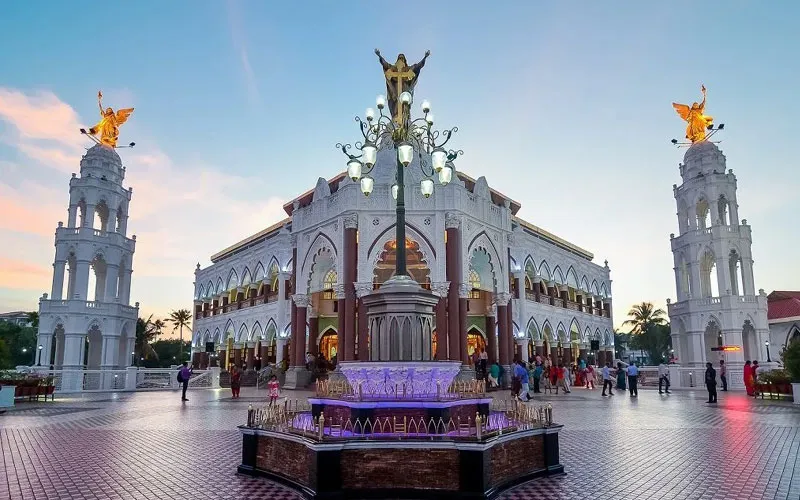
Introduction
St. George’s Syro-Malabar Forane Church, locally known as Edapally Church is a Catholic pilgrimage church in Edapally, Kochi, India. It is considered as Asia’s largest shrine dedicated to Saint George, about five million people visit it every year.The church is believed to have been established in 593 AD, making it one of Kerala’s oldest churches, following the seven churches founded by Thomas the Apostle in the first century AD (citation needed). Initially, the church was dedicated to Marth Mariam (Virgin Mary). In 1080, a new church was constructed next to the original one. Each year, a nine-day festival is held as part of the Feast of Saint George (April 23). Additionally, the church, frequented by non-Christians as well, receives offerings of gold, chicken, and eggs.
The church boasts a history spanning 14 centuries. Its perennial well has drawn numerous visitors, transforming the church into a revered pilgrimage site.
Historians suggest that Thomas the Apostle (Mar Thoma Sleeha in Malayalam/Syriac) erected seven churches, with Edapally Church being established during the sixth century, closely following the construction of these seven churches.
A striking feature of the church is the prominent statue of St. George (Mar Geevarghese Sahada) on horseback, depicted slaying a serpent beneath his horse’s hooves. This church seamlessly intertwines elements of religion, magic, myth, folklore, and history. Edappally, originally a hamlet within the princely kingdom of Elangalloor, housed a small Syrian Christian congregation, descendants of those converted by St. Thomas the Apostle in 52 AD. The oldest Edappally church, erected in 593, remains preserved as a storeroom, constructed by families from Paravur who previously journeyed to the Kottakkavu Mar Thoma Syro-Malabar Church, North Paravur, for worship.
As the congregation grew, a second church was built in 1080. Its primary altar and facade underwent renovations during the 1970s, with the addition of a Virgin Mary picture. The original tile floor remains intact.
On January 18, 1994, the church celebrated its 1400th anniversary, graced by the presence of Mother Teresa from Calcutta. To mark the occasion, a bell tower was erected on the church grounds and a bell installed, later relocated to the archangel tower of the new church.
Blessed by Pope John Paul II, the foundation stone for the third church was laid on January 1, 2001. This octagonal structure, standing 141 feet tall, covers an area of 88,000 square feet, making it one of India’s largest churches. Combining European and Keralite architectural elements, its teak main altar is adorned with gold foil imported from Italy, complemented by two bell towers. Sculptures depicting scenes from the Old and New Testaments adorn the church, with the Resurrection depicted on the altar surrounded by carvings in Vietnamese marble. The main chapel, spanning 19,500 square feet, accommodates 5,000 individuals, while the entire church can host up to 10,000 people. The two older churches have been preserved for their historical significance.
The architects of the new church were Vastushilpalaya and Prasanth P George. Within the church courtyard lies a well, believed by devotees to possess healing properties in its waters.
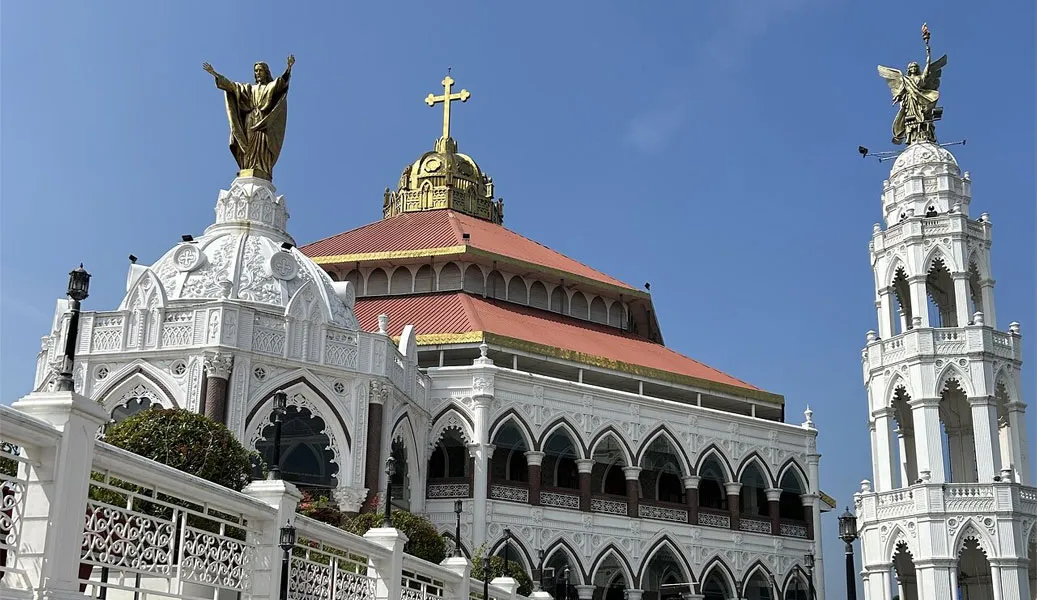
Historians state that Thomas the Apostle (Mar Thoma Sleeha in Malayalam/Syriac) established seven churches. The Edapally church, constructed during the sixth century, followed closely after the building of these seven churches.
Church Built in 593 A.D
Edappally was a small village within the princely realm of Elangalloor, inhabited by a modest Syrian Christian community, descendants of those converted by St. Thomas the Apostle during his visit to India in 52 AD. The earliest church in Edappally was constructed in 593 AD by families from Paravur, who had to make the journey to Kottakkavu Mar Thoma Syro-Malabar Church, North Paravur, for worship.
Initially dedicated to the Virgin Mary, locally known as Marth Mariam, the church eventually came to be associated with Saint George after he was declared the patron saint of England. Erected approximately 300 years following St. George’s martyrdom, the church pays homage to his legacy as a former soldier turned devout follower of Christ, who adhered strictly to scripture. He met his martyrdom for resisting religious persecution under Emperor Diocletus. Following his death, numerous churches were established across Europe and beyond in his honor. A notable feature of the church is the prominent statue of St. George (Mar Geevarghese Sahada) on horseback, depicted slaying a serpent under his horse’s hooves. Today, the church serves as an Adoration Chapel, attracting numerous visitors year-round.
Church Built in 1080 A.D
As the congregation expanded, the original church became too small, prompting the construction of a second church in 1080. The primary altar and facade of this new church underwent renovations in the 1970s, including the addition of a picture of the Virgin Mary. The imported-tile floor remains intact. Presently, the second church has been repurposed as a museum.
Church Built in 2015 A.D
On January 1, 2001, the foundation stone for the third church, blessed by Pope John Paul II, was laid. This octagonal church, standing at 141 feet high (43 m), spans an area of 88,000 square feet (8,200 m2) and ranks among India’s largest churches. Combining European and Keralite architectural styles, its main altar is crafted from teak and adorned with gold foil imported from Italy, complemented by two bell towers. Sculptures depicting scenes from the Old and New Testaments, including the stories of original sin, Noah’s Ark, Cain and Abel, and the life of Jesus, adorn the church. The altar, representing the Resurrection, is encircled by carvings in Vietnamese marble. The main chapel, covering 19,500 square feet (1,810 m2), accommodates 5,000 individuals, while the entire church can host 10,000 people. The two older churches have been preserved for their historical significance.
Organizations
Darsana Samooham is a lay religious organization affiliated with the church, devoted to either the Virgin Mary or a saint associated with a religious order. The Darsana Samooham in Edappally holds the distinction of being the world’s largest. Members typically don religious attire and are governed by an elected committee comprising a president, treasurer, and secretary. This group plays a pivotal role in organizing the annual feast and actively participates in the festival procession.
The Marian Sodality, established by Payyappilly Joseph Kathanar in 1927, aims to foster spirituality among the parish youth. Similarly, the Cherupushpa Mission League, founded in 1972, endeavors to imbue Christian values in the parish’s younger generation. Thirubalasakyam, a children’s organization affiliated with the church, boasts membership from the majority of children within the parish.
The St. Joseph’s Maranananthara Sahaya Fund is a collective effort of parishioners aimed at aiding financially burdened families within the parish with funeral expenses. Funding for this initiative is sourced from life memberships or monthly contributions collected from members. Managed by the church, St. George’s Charitable Fund extends financial support to the underprivileged, irrespective of their religious affiliation.
Mar Giwargis Sahada
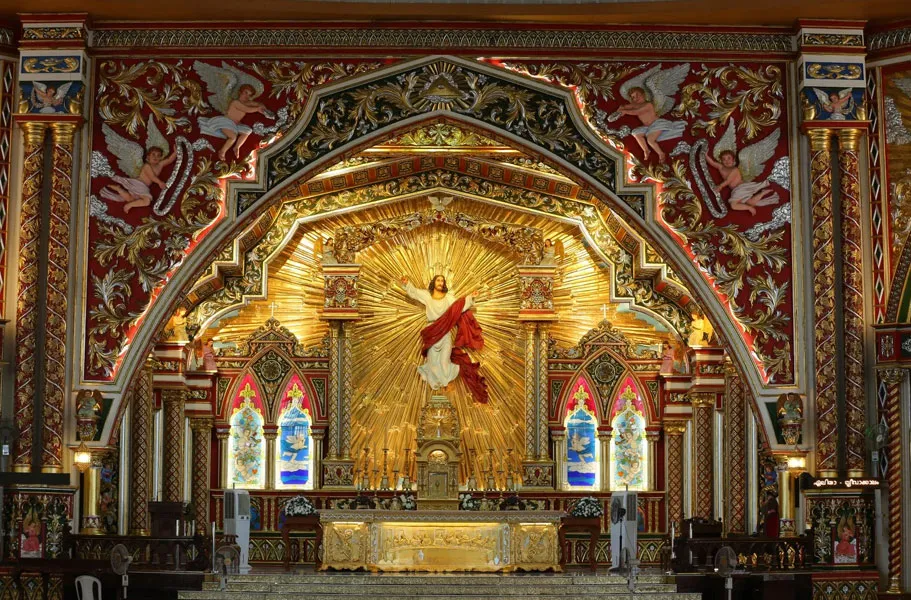
The church was constructed approximately 300 years after the martyrdom of Saint George (Mar Giwargis Sahada). Born in Lod, Syria Palaestina around AD 275–285, Mar Giwargis served as a soldier and attained the rank of tribunus in the imperial guard of Emperor Diocletian at Nicomedia. A devout Christian, he adhered to the teachings of Christ throughout his life. Mar Giwargis valiantly defended his faith during the Diocletianic Persecution and ultimately met his demise. Following his death, numerous churches were established across Europe and parts of the East in honor of St. George, who is recognized as the patron saint of England.
The church in Edappally came to be known as St. George’s Church, featuring a statue of St. George on horseback. This depiction portrays the saint and his horse vanquishing a serpent, symbolizing the triumph over evil.
Annual Feast Day
Feast day: 3rd and 4th of May
The annual feast day of St. George’s Syro-Malabar Forane Church, Edappally, is celebrated on 3rd and 4th of May every year.
Mass Timing
Weekly Masses
Monday to Thursday : 6:00 am, 7:00 am, 6:00 pm
Friday : 6:00am, 7:00am, 12:00pm, 6:00pm
First Friday : 5.45 am, 7:00 am, 9:00 am, 10.30 am, 12:00pm(Latin), 3.30pm, 5:00pm, 7:00pm
Confession- 6.00am to 8.00 am 9.00 am to 1.00pm & 3.30pm to 5.30pm
Weekend Masses
Saturday : 6:00 am, 7:00am, 6:00pm
Sundays : 5.45am, 7:00am, 8.45 am, 10.15am
4.30pm, 5.30pm, 7.00pm
Contact Info
Palarivattom – Edappally Rd,
Ponekkara,
Edappally,
Kochi,
Ernakulam,
Kerala,
682024,
India.
Phone No.
Phone: 0484 245 2678
Accomodations
How to reach the Sanctuary
Airway
The nearest major airport to the St. Thomas Church, Thumpoly is Kochi International Airport. which is 21.8 km away from the Shrine.
Railway
The nearest Railway to the St. Thomas Church, Thumpoly is Edapally Metro Station,. which is 600 meter away from the Shrine.

